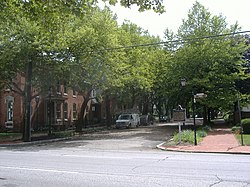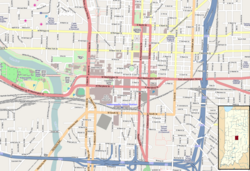Lockerbie Square Historic District
|
Lockerbie Square Historic District
|
|

North East Street and Lockerbie Street is the location of the Lockerbie Square Historic Marker
|
|
| Location | bounded by Michigan and Davidson Sts., New York Ave., and New Jersey St., Indianapolis, Indiana |
|---|---|
| Coordinates | 39°46′20″N 86°08′50″W / 39.77222°N 86.14722°WCoordinates: 39°46′20″N 86°08′50″W / 39.77222°N 86.14722°W |
| Area | 10.9 acres (4.4 ha) |
| NRHP Reference # | 73000038, 87000734 (Boundary Increase) |
| Added to NRHP | February 23, 1973, July 28, 1987 (Boundary Increase) |
Lockerbie Square Historic District is a national historic district on the National Register of Historic Places within Indianapolis, Indiana, listed on February 23, 1973, with a boundary increase on July 28, 1987. It is noted for its Federal, Italianate, and Queen Anne style architecture. The original platting of Lockerbie Square, done by Jannett Smith Lockerbie McOuat and named for her father, Scottish immigrant George Murray Lockerbie, was between 1847 and 1850. The 1960s saw an immense effort to save the buildings within the district, becoming the first historic district in Indianapolis. Many of the buildings date from 1855 to 1930. James Whitcomb Riley, famed Hoosier poet, lived in the district for over two decades. He was known to give candy to local children on his regular walks.
Lockerbie Square is the oldest intact residential neighborhood of Indianapolis. Lockerbie is located on the northeast side of Alexander Ralston's Plat of Indianapolis at the intersection of East Street and New York Street. The western border of the district is East Street, so named as it was the original eastern boundary of Indianapolis. The neighborhood is directly south of the Mass Ave Cultural District and north of the Cole-Noble District. At only .75 miles away from the Circle, Lockerbie Square was one of Indianapolis' earliest walkable suburbs.
At one point, it was called Germantown, due to the numerous German immigrants living in the district starting in 1849.
The housing demand in the 1880s caused the Lockerbie District to prosper and grow.
After World War I, residents of means moved to northern Indianapolis. The neighborhood decayed until the restoration efforts of the 1960s and 1970s began. The newly founded Historic Landmarks Foundation of Indiana helped to restore the area, basing their renovations on the preservation techniques practiced at the German Village of Columbus, Ohio.
...
Wikipedia




